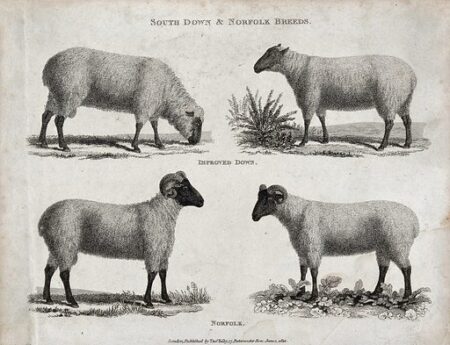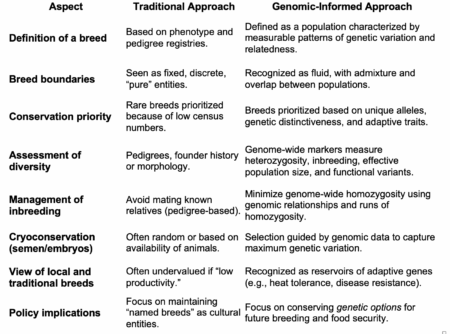- King Charles III talks about seeds with Dr Elinor Breman of Kew’s Millennium Seed Bank and…
- …Cate Blanchett.
- Or read about it in The Economist.
- Or watch a nice video.
- The seed banks of the National Plant Germplasm System in the USA are for farmers, not just researchers.
- How to get stuff out of the NPGS.
- Laurajean Lewis: from an NPGS genebank to CIMMYT’s.
- I’m sure she and Chris Mujjabi will get to know each other soon.
- Diane Ragone: Not all genebanks are seed banks.
- Not a lot of breadfruits in Belgium but, surprisingly, lots of bananas.
Nibbles: Ancient Mexican seedbank, Indian millets, Foraged foods, Soybean breeding, Apple breeding, Albanian heirlooms, Bangladesh fish genebank
- People in the Nejapan Sierra Sur in Oaxaca, Mexico had a seed bank 400-700 years ago so they could re-create their complex cuisine after disruptions.
- How MSSRF revived millets in Odisha, India. You think a seed bank was involved?
- Meanwhile, in Meghalaya (also India), foraged foods are helping to diversify state-provided school lunches and address chronic malnutrition. Talk about complex cuisine. Are all these species in a seed bank somewhere, though? Do they need to be?
- How the National Soybean Germplasm Collection at the Agricultural Research Service lab in Urbana, Illinois helped save soybeans in Iowa.
- University breeding programmes are keeping the apple afloat in the USA. That and genebanks.
- Farmers and agrotourism are bringing back some cool flavors in Albania. Well, that and the Albanian Gene Bank.
- Fish need genebanks too, and Bangladesh is on it. Did ancient Bangladeshis have them, I wonder?
Nibbles: Corn diseases, German potato collection, Vietnam rice trials, Endophyte strain, Fish nutrition, Himalayan pea, Subversive seeds
- The US needs better maize.
- German genebank looks for the best potatoes.
- Vietnam looks for better rice in IRRI’s genebank.
- New Zealand markets an endophyte for better grass performance.
- Some Timor-Leste fish are better than others.
- The Himalayas have a better pea. Of some kind.
- How’s that for subversive cataloguing?
A breed is a breed is a breed?
I feel maybe yesterday’s Nibble on the definition of a “breed” may have been a bit too laconic, even for me. So let me give a bit more context.

The link was to a YouTube playlist, which was described thus (link added):
The presentations in this playlist are from the webinar on “Genomic assessment of genetic variation and the future of the breed concept”, originally held on 12.12.2024 under the umbrella of the Food and Agricultural Organization (FAO). This represents the culmination of collaborative work by a diverse group of experts from institutions from all around the world to prepare materials for a sub-chapter in the upcoming 3rd Report on the State of the World’s Animal Genetic Resources for Food and Agriculture.
It amounts to over an hour of talks, but if I had to summarize the point the playlist is making, it is that genomics is redefining a breed as a fluid, porous, genotypically-characterized population rather than a fixed, pedigree-based, phenotypic entity. Thus, it is shifting livestock conservation from saving labels (“Breed A”) to preserving genetic options.
Here’s a handy table I came up with to describe the change:
Interesting to juxtapose this to the post a few days ago on how to value and use Indigenous knowledge to solve today’s problems. Would Indigenous livestock keepers necessarily care about those genetic options more than their traditional breed?
It would be great to hear from people engaged in livestock conservation on this. It’s unfortunately not a community I interact with much.
Brainfood: Core collections of…durum, deulkkae, barnyard millet, durian, sesame, flax, Fendler’s horsenettle, jute mallow, barley
- Creation of a core set of durum wheat accessions based on agro-morphological traits with maximum diversity and lower redundancy. From 710 to 13 accessions (2%!) using 32 morphological traits, thanks to Power Core.
- Construction of a core collection of Perilla frutescens (L.) Britton Germplasm in the South Korean gene bank using agro-morphological traits. From 1227 to 235 accessions (19%) using 17 morphological traits, thanks to a bunch of different methods.
- Comprehensive Phenotyping of 1,807 Indian Barnyard Millet (Echinochloa frumentacea Link) Accessions from Indian National Genebank: Unlocking Diversity for Core Set Development. From 1,807 to 271 accessions (15%) using 23 quantitative traits, thanks to Core Hunter 3.
- Genomic resequencing reveals genetic diversity, population structure, and core collection of durian germplasm. From 114 to 26 accessions (23%) using 39 million high-quality SNPs across the genome.
- Development of a composite core collection from 5,856 sesame accessions being conserved in the Indian National Genebank. From 5,856 to 1,768 accessions (30%) using SNPs and phenotypic data.
- Optimizing core collections for genetic studies: a worldwide flax germplasm case study. From 1,593 to 350 accessions (22%) using phenotypic and genotypic data, times 200, thanks to CoreCollection, corehunter III, TrainSel, and more.
- An Optimized Core Sample of the Wild Potato Solanum fendleri in the USA. From 269 accessions, to 38 plants, to 1 accession (0.4%!). Beat that!
- Countrywide Corchorus olitorius L. core collection shows an adaptive potential for future climate in Benin. From 305 to 54 accessions (18%) using 1,114 high-quality SNPs, thanks to ShinyCore. Some indication of usefulness.
- Multi-environmental evaluation of barley core collection against spot blotch for genetic variability and identification of promising genotypes exhibiting resistance. From a core collection of 678 accessions to 2 genotypes that might actually be useful to breeders. Finally!
